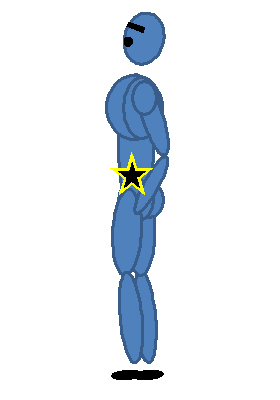1
Physics in Ballroom Dancing: Balance and Stability, Part 2.
Text: Kerstin Lange Photography and Diagrams: Helmut Römhild
To dance means to move.
But it is also true that dancing is about how to stand correctly:
balance and stability are extremely important for a dancer.
To understand what happens in the state of balance and what stability means it
helps to keep in mind that dancing takes place on the surface of planet Earth.
Here forces act on the dancer’s body in a characteristical way.
Gravity pulls the body to the floor, the floor counters with a ‘push’, providing support and friction.
Muscles move the dancer’s body working against gravity and support while other forces outside the body
(e.g. the partner) add to the sum of forces and counterforces, of pushes and pulls in and from various directions.
Balance is achieved when the center of gravity and the support are vertically aligned.
Stability during movement means to keep the center of gravity inside an area of support which
permanently changes size and position.
To maintain stability means to arrange the body parts into the optimal shape.
The body consists of many separat parts.
To maintain stability means to arrange the body parts into the optimal shape
which fits the goal: to bring and keep the center of gravity above the area of support.
Rigidity has to be combined with the flexibility to control the posture.
It means to feel the body’s position, understand the information which joints and muscles send to the brain
and to be able to react accordingly.
The center of gravity of a person simply standing on both feet is inside the abdominal area,
slightly higher in the male body than in the female.
Physics in Ballroom Dancing.
The biomechanics of ballroom dancing combine the physical and anatomical dimensions of movement and rest.
In the articles ‘Physics in Ballroom Dancing’ you find considerations about the physical framework inside which dancesports happens.
The physical basics discussed in this article are taken from the following publications:
Prof. Dr. George D. Gollin, The Physics of Dance, University of Illinois, 2001.
Prof. Dr. Kenneth Laws, Physics and the Art of Dance, Oxford University Press, 2002.
Keeping the balance – especially when the center of gravity shifts outside the body!
Making a step forward means that one leg has to be extended.
Doing this the body dramatically changes shape and the center of gravity shifts outside the body.
This happens while the area of support is extremely small: the dancer is standing on one foot.
In such a position the body inevitably starts to tilt forward.
Lowering the body means to lower the center of gravity.
Lowering the center of gravity increases stability.
A low center of gravity increases stability: how it works.

The body, flexible but nonetheless rigid, acts like a rod and the small area of support, the foot, like a pivot point.
When the rod or the body starts to tilt around the pivot point, a high center of gravity is soon far away from the area of support while a low center of gravity is still close to it, making it easier to readjust the body.
| • |
vertically aligning the area of support with the center of gravity, |
| • |
shifting the center of gravity backwards over the heel of the supporting foot, |
| • | moving the hip of the extended leg backwards which brings a substantial portion of the body to the back and shortens the part of the legt which is in front of the area of support, thus countering the extended leg’s weight. |
The ever present instability is the prerequisite to move at all.
Without any countermeasures the body simply starts to fall forward and
suddenly it becomes very clear that the dancer’s stability is only shortlived,
always on the verge of collapse.
But that’s no accident: the ever present instability is the prerequisite to move at all.
In fact extending a leg is one of the most efficient ways to make the upright body move.
Swinging a leg forward or backward adds a centrifugal force to the tilt and
pulls the body backward or forward.
Ballet dancers use this method to initiate powerful movements.
![]()
©: Ballroom Website, 2010
Aktualisiert: 03.05.2010




